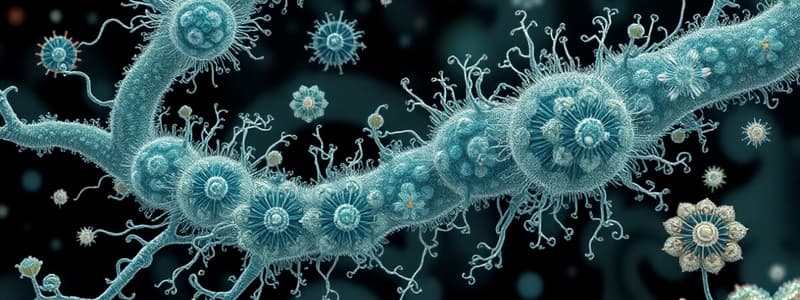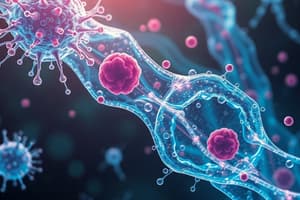Podcast
Questions and Answers
Which of the following is an example of a fomite?
Which of the following is an example of a fomite?
- A contaminated needle (correct)
- A coughing person
- An infected animal
- A mosquito
Which of the following is a characteristic of airborne transmission?
Which of the following is a characteristic of airborne transmission?
- The pathogen is transmitted through direct contact.
- The pathogen travels less than a meter.
- The pathogen is transmitted through contaminated food.
- The pathogen travels more than 1 meter. (correct)
What is the term for bacteria that live in a healthy person without causing harm but can become pathogens under certain conditions?
What is the term for bacteria that live in a healthy person without causing harm but can become pathogens under certain conditions?
- Commensal bacteria
- Transient flora
- Virulent bacteria
- Opportunistic pathogens (correct)
Which of the following is NOT a mode of transmission for infectious agents?
Which of the following is NOT a mode of transmission for infectious agents?
Which of the following diseases is NOT typically transmitted through contaminated food or water?
Which of the following diseases is NOT typically transmitted through contaminated food or water?
What type of vector carries pathogens passively on their body parts?
What type of vector carries pathogens passively on their body parts?
Which of the following is an example of an application of applied microbiology in the medical field?
Which of the following is an example of an application of applied microbiology in the medical field?
Which of the following is an example of a transient flora?
Which of the following is an example of a transient flora?
Which of the following is a major factor that can disrupt the balance of normal flora and lead to opportunistic infections?
Which of the following is a major factor that can disrupt the balance of normal flora and lead to opportunistic infections?
What term describes the transmission of a pathogen through direct physical contact from one person to another?
What term describes the transmission of a pathogen through direct physical contact from one person to another?
Which of these organisms are classified as prokaryotes?
Which of these organisms are classified as prokaryotes?
Which branch of microbiology focuses on the study of how microorganisms impact human health?
Which branch of microbiology focuses on the study of how microorganisms impact human health?
Which of the following is NOT a characteristic of a bacterial spore?
Which of the following is NOT a characteristic of a bacterial spore?
What is the primary difference between bacteria and archaea?
What is the primary difference between bacteria and archaea?
Which of these is an example of a non-cellular microorganism?
Which of these is an example of a non-cellular microorganism?
What is the name of the process by which bacteria form spores?
What is the name of the process by which bacteria form spores?
Which of the following is NOT a branch of microbiology?
Which of the following is NOT a branch of microbiology?
What is the primary function of algae within the ecosystem?
What is the primary function of algae within the ecosystem?
Which type of microorganism is responsible for causing mad cow disease?
Which type of microorganism is responsible for causing mad cow disease?
What is the primary difference between viroids and viruses?
What is the primary difference between viroids and viruses?
What is the primary function of lysosomes in a cell?
What is the primary function of lysosomes in a cell?
Which of the following is NOT a characteristic of inflammation?
Which of the following is NOT a characteristic of inflammation?
What is the main function of cilia found on the surface of certain cells?
What is the main function of cilia found on the surface of certain cells?
Which type of immune cell is responsible for producing antibodies?
Which type of immune cell is responsible for producing antibodies?
What is an example of a nonspecific defense mechanism?
What is an example of a nonspecific defense mechanism?
What is the function of interferon?
What is the function of interferon?
Which of the following is a characteristic of systemic inflammation?
Which of the following is a characteristic of systemic inflammation?
What is the main difference between a killer T-cell and a memory T-cell?
What is the main difference between a killer T-cell and a memory T-cell?
What type of cell is responsible for the 'secondary response' in antibody-mediated immunity?
What type of cell is responsible for the 'secondary response' in antibody-mediated immunity?
Which of the following accurately describes the process of germination in microorganisms?
Which of the following accurately describes the process of germination in microorganisms?
Flashcards
Germination
Germination
Process where spore form changes into vegetative form when conditions improve.
Mitochondria
Mitochondria
Organelles that produce ATP, the energy currency of the cell.
Ribosomes
Ribosomes
Small RNA granules involved in protein synthesis, some are free, others attached to ER.
Endoplasmic Reticulum (ER)
Endoplasmic Reticulum (ER)
Signup and view all the flashcards
Golgi Apparatus
Golgi Apparatus
Signup and view all the flashcards
Lysosomes
Lysosomes
Signup and view all the flashcards
Phagocytosis
Phagocytosis
Signup and view all the flashcards
Cell-mediated Immunity
Cell-mediated Immunity
Signup and view all the flashcards
Antibody-mediated Immunity
Antibody-mediated Immunity
Signup and view all the flashcards
Normal Flora
Normal Flora
Signup and view all the flashcards
Transient Flora
Transient Flora
Signup and view all the flashcards
Opportunistic Pathogens
Opportunistic Pathogens
Signup and view all the flashcards
Contact Transmission
Contact Transmission
Signup and view all the flashcards
Droplet Transmission
Droplet Transmission
Signup and view all the flashcards
Airborne Transmission
Airborne Transmission
Signup and view all the flashcards
Food-borne Transmission
Food-borne Transmission
Signup and view all the flashcards
Bodily Fluid Transmission
Bodily Fluid Transmission
Signup and view all the flashcards
Vector Transmission
Vector Transmission
Signup and view all the flashcards
Bioremediation
Bioremediation
Signup and view all the flashcards
Microbiology
Microbiology
Signup and view all the flashcards
Microorganisms
Microorganisms
Signup and view all the flashcards
Prokaryotes
Prokaryotes
Signup and view all the flashcards
Eukaryotes
Eukaryotes
Signup and view all the flashcards
Taxonomy
Taxonomy
Signup and view all the flashcards
Sporulation
Sporulation
Signup and view all the flashcards
Endospores
Endospores
Signup and view all the flashcards
Viruses
Viruses
Signup and view all the flashcards
Prions
Prions
Signup and view all the flashcards
Study Notes
Microbiology
- Study of organisms too small to see without magnification
- Originated with invention of microscope
- Microorganisms include bacteria, viruses, fungi, protozoa, helminths (worms), algae, prions
Branches of Study
- Immunology
- Public health microbiology and epidemiology
- Food, dairy, and aquatic microbiology
- Biotechnology
- Genetic engineering and recombinant DNA technology
- Manipulating genes
Microbes' Roles
- Nutrient production and energy flow
- Decomposition
- Biotechnology (food, drug, vaccine production)
- Genetic engineering
- Bioremediation
- Infectious disease
Classification of Microorganisms (Protists)
I - Cellular
- Prokaryotes: lack a true nucleus, include archaea, bacteria, & blue-green algae
- Eukaryotes: have a nucleus, examples include algae (except blue-green), fungi, & protozoans.
II - Non-Cellular
-
Viruses, viroids, prions
-
Taxonomy: The formal system of organizing, classifying, and naming living organisms. - Bacteria: prokaryotic, unicellular organisms that are found in varied environments - Archaea: prokaryotic, unicellular organisms that thrive in harsh environments (high salt, extreme temperatures) - Algae: eukaryotic, unicellular or multicellular organisms, that photosynthesize - Fungi: eukaryotic, unicellular or multicellular organisms - Protozoa: eukaryotic, unicellular or multicellular organisms that are animal-like - Viruses: noncellular particles, need electron microscopy for visualization
Bacterial Life Cycle
- Vegetative Form: metabolically active, growing, and multiplying, causes infection
- Spore Form: inert, resting, non-growing, and non-multiplying resistant form
Cytoplasmic Organelles
- Mitochondria: powerhouses of cells, generate ATP
- Ribosomes: protein synthesis
- Endoplasmic Reticulum (ER): lipid and protein synthesis; transport - Smooth ER: lipid synthesis - Rough ER: protein synthesis
- Golgi Apparatus: shipping center for cellular products
- Lysosomes: digestive enzymes
- Centrioles: involved in cell division
- Cilia/Flagella: movement of substances/ cells
- Chloroplasts: (in algae and plants) convert light energy into chemical energy
Defense Mechanism Against Infection
- Nonspecific Mechanisms: act against all harmful agents (nonspecific resistance)
- Specific Mechanisms: act against specific agents (immunity)
- Virulence: degree of pathogenicity or disease-causing power
Nonspecific Defense Mechanisms
- Intact skin and mucous membranes
- Fluids (tears, saliva, urine) flush pathogens
- Complements (proteins) activate phagocytosis and inflammation
- Interferons: protect uninfected cells from viruses
- Phagocytosis (neutrophils, monocytes/macrophages)
- Inflammation (redness, heat, swelling, pain)
Specific Defense Mechanisms (Immunity)
- Cell-mediated Immunity: uses T-cells (killer T-cells, memory T-cells) targeting viruses and fungi
- Antibody-mediated Immunity: uses B-cells (plasma cells, memory B-cells) targeting bacteria with antibodies
Normal Flora (Microbiota)
- Resident Flora: normal microbiota present throughout a person's life
- Transient Flora: microorganisms that remain for a short time
Modes of Transmission
- Contact (direct or indirect)
- Droplet (less than 1 meter)
- Airborne (greater than 1 meter)
- Waterborne and Foodborne
- Vectorborne.
Applied Microbiology
- Includes various applications (food production, alcoholic beverages, water treatment, pharmaceuticals, agriculture, bioremediation, forensics, energy)
Studying That Suits You
Use AI to generate personalized quizzes and flashcards to suit your learning preferences.



